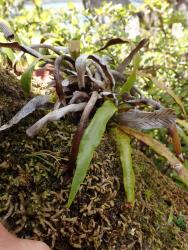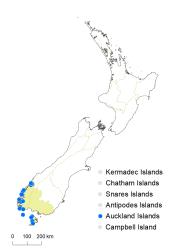- ≡ Grammitis rigida Hombr. in Hombron & Jacquinot, Voy. Pôle Sud, Bot. t. 2f (1843)
- ≡ Polypodium australe var. rigidum (Hombr.) Cockayne, Trans. & Proc. New Zealand Inst. 36: 325 (1904) – as P. australe rigida
- ≡ Polypodium billardierei var. rigidum (Hombr.) Cockayne, Trans. & Proc. New Zealand Inst. 40: 305 (1908)
- = Grammitis crassa Fée, Mém. Foug., 5. Gen. Filic. 234 (1852)
Rhizomes erect to short-creeping, bearing scales. Rhizome scales narrowly ovate, 8–15 mm long, 1.0–2.4 mm wide, pale brown to red-brown, concolorous, non-clathrate. Stipes indistinct, winged almost to base, glabrous. Fronds undivided, narrowly elliptic to narrowly obovate, 75–220 mm long, 9–20 mm wide; apices acute; margins entire or with occasional projections; bases attenuate to an indistinct winged stipe; dark green adaxially, paler green abaxially; coriaceous; glabrous or bearing sparse brown hairs up to 1.2 mm on the abaxial surface of the midrib and lamina. Hairs simple catenate, or branched with catenate branches. Hydathodes absent. Sori elliptic, elongated along veins, oblique, 2–10 mm long, in 12–30 pairs in mid to upper part of lamina, lacking hairs. Sporangia 240–400 µm long; spores 30–57 µm diameter.
Notogrammitis rigida is characterised by its erect to short-creeping rhizome, lack of distinct stipes, and more or less glabrous fronds, up to 220 mm long and 20 mm wide with occasional marginal projections. It is easily the largest undivided species of the genus in New Zealand and is confined to high rainfall, coastal areas in the far south of the country. It lacks setae and hairs with setiform branches.
South Island: Southland, Fiordland.
Solander Island, Stewart Island, Auckland Islands.
Altitudinal range: 0–300 m.
Notogrammitis rigida is a rare fern found only in coastal habitats close to the sea in Southland and Fiordland, and on Solander Island, Stewart Island / Rakiura and the Auckland Islands. It reaches 300 m on Solander Island.
Notogrammitis rigida is found in beech, Olearia colensoi and Metrosideros umbellata forest, or under mānuka. It grows amongst mosses on wet coastal rocks, cliffs and slips, often very close to the sea. It is also epiphytic on Metrosideros umbellata or, more rarely, found in the spray zone of waterfalls.
Notogrammitis rigida was given a conservation status of Naturally Uncommon by de Lange et al. (2018).





